links to other pages
Tombstones
Religious inscriptions
Just as in the modern world, these were very important reasons for the people of Roman Britain to create inscriptions of various kinds. Line-drawings and translations are available for all these artefacts.
We will first look at how various Roman Emperors as well as local politicians and dignitaries showed that they wanted to be associated with this important sacred site.
P1.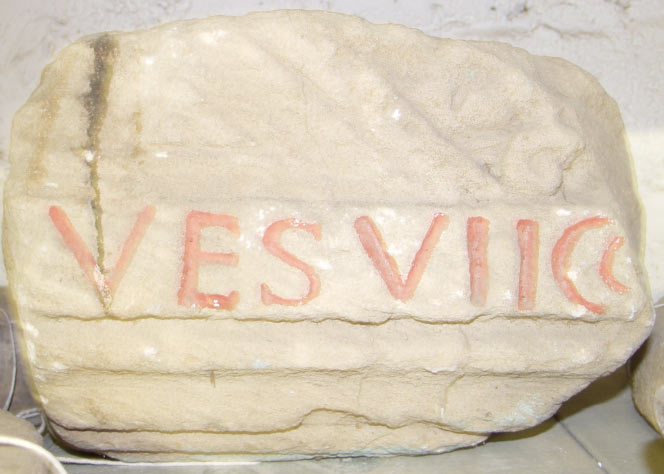
This is the first building inscription recorded at the Roman Baths. It gives the name of the Roman
emperor Vespasian VES, who first came to Britain as a general in the Emperor Claudius' invading army in 43 AD.
VII C tells us that it was inscribed during the 7th year in which he held the consulship. Since we know he came to power in 69 we can tell that the Baths were definitely standing by 75AD.
Perhaps we might have expected Vespasian to be more cautious, since the magnificent temple which Claudius had built for himself (or at least his divinity) in Colchester had been a focus for the anger of Boudica and her rebelling Iceni tribe during the 60's AD. At least he was not expecting the Britons to worship his own divinity, but was instead building a temple for the local goddess.
P2.

This lead ingot is known as a 'pig'.
IMPeratoris HADRIANI AVGusti : It is easy to recognise the Emperor Hadrian's name here, even though the spelling of his name might seem odd. The endings '-is' and 'i' are the Latin way of showing possession, rather like our apostrophe 's'. A word with these endings is described as being 'in the GENITIVE case.
This pig weighs 88.45kg and the inscription dates it to 117-38 AD. All precious metals and mines throughout the Empire belonged to the Emperor, so this shows that the Emperor had authorised the use of vast quantites of lead for all the plumbing and lining work at the Baths. Lead was mined in the Mendips. The museum also contains sections of lead piping, some with inscriptions, showing that lead was tracked constantly as it was being used.
P3a & P3b
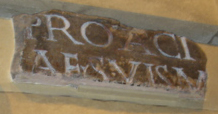
PROTACIV / AE SVLIS M
LAVDIVS LIGVR / AE NIMIA VETVS
These two sections of a building inscription are from the building with the Luna pediment near to the sacred spring. They record the names of two people who must have been members of the Ordo or Town Council. These decuriones would be expected to contribute to the building of public monuments, and by publicising their names they would hope for continued success in the local elections. A third inscription tells us that a Guild or Trade Union (COLLEGIO) had also been involved for a long sequence of years (LONGA SERIA )and that someone used their own money (sua pecUNIA) to have it repaired and repainted (REFICI ET REPINGI CURavit). There are some beautiful ligatures and reversed letters in these inscriptions which make them very interesting to decipher.
Gaius PROTACIVs : The ligatured A and T can be seen more clearly on the line drawing which shows Gaius Protacius' name.
deAE SVLIS Minervae : The endings '-ae' and 'is' are the Latin way of showing possession, rather like our apostrophe 's'. A word with these endings is described as being 'in the GENITIVE case. = "of the goddess Sulis Minerva"
.................................
cLAVDIVS LIGVR Claudius Ligur
AE NIMIA VETVSTate This refers to the excessive age of something - possibly the building, and this was why it needed repairing.
P4.
This stone records the restoration of a sacred building after it had been vandalised and desecrated, so it is really a building inscription even though it looks rather like an altar and it includes a dedication to the 'Virtue and Deity of the Emperor'.
LOCUM RELIGIOSUM PER INSOLENTIAM ERVTVM This holy place, wrecked (ERUTUM) by vandalism
VIRTVTI ET NVMINI AUG[usti] To the virtue and deity of the Emperor - notice that the words are in the Dative case, ending in 'i' to signify 'to'. This dedication probably means more than the modern equivalent, which might be to commemorate something or someone. Gaius Severius Emeritus has restored the building as an offering to the deity or divine spirit of the Emperor and to his 'virtus' or the personification of his honour and courage.
RESPVRGATUM REDDIDIT (Gaius S E - on next line) has restored it, cleansed again
G[aius] SEVERIUS EMERITVS Gaus Severius Emeritus,
> REG[ionarius] the centurion in charge of the area. ( >or ) = centurion)
It is interesting to speculate whether the sanctuary might have been desecrated by Christians, and that is why it needed rebuilding, but nothing is otherwise known of this incident. Christians were persecuted sporadically in the Roman Empire - usually when scapegoats were needed for something e.g. the fire in Rome in 64AD during Nero's reign, because Christians refused to worship other gods (even the divinity of the Emperor!) - but after the 'conversion' of the Emperor Constantine in 312AD the religion was actually favoured and promoted. The Emperor Julian tried to restore paganism during the 360's AD.
P5.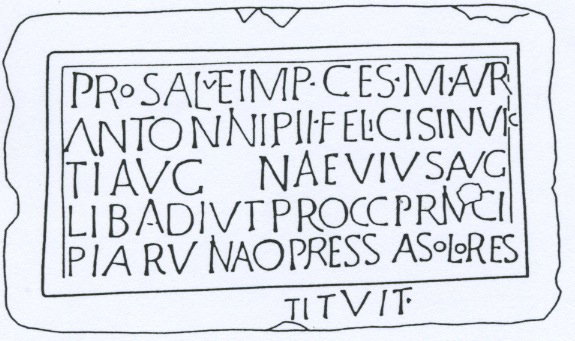
This building inscription is kept in storage at the museum. It was found at Combe Down outside Bath, at what is thought to have been the headquarters (PRINCIPIA - lines 4 - 5) of an estate belonging to the Emperor for the distribution of Bath stone from the quarries.
You can see the name of the person who dedicated the stone in the middle of the third line : NAEVIUS, who is described as an Imperial freedman (AUGusti LIBertus) and the Procurator's Assistant (PROCuratoris). He restored the ruined HQ (Principia) back from ground-level (a solo) after it had been knocked down (PRINCIPIA RUINA OPpRESSa A SOLO RESTITUIT).
The first two words mean 'For the welfare of' (PRO SALUTE) and all the following words until we get to Naevius' name are the names of the Emperor! All the names are in the Genitive Case (- ending in 'is' or 'i' and used in Latin instead of a word for 'of'). IMPeratoris CAESaris Marci AUReli ANTONINI PII FELICIS INVICTI AUGusti. Emperor Caesar Marcus Aurelius Antoninus Pius Felix Invictus Augustus. He is better known to us as Caracalla, who ruled from 211-218 AD.
P6.
This small object is a seal made of lead, which was found at the same site as the building inscription above. It has a drawing of a stag, which is taken to be the badge of the province of Upper Britain : Britannia Superior. (The badge of Britannia Inferior - in the north - was apparently a bull).
P B R S = PROVINCIAE BRITANNIAE SUPERIORIS : "of the province of Britannia Superior".
Notice again the Genitive endings of all the words - they end in 'ae' or 'is' which denotes the possessor = 'of' or an apostrophe 's'
Small packages and letters would have been sealed with string and a wax seal protected by a copper alloy sealbox, but bulkier parcels and official stores were sealed with lead. Some lead seals were used by private merchants but many were controlled by the army or civil administration and used in the same way as modern Customs and Excise sealings. This example was attached to goods belonging to the Province of Upper Britain, whose capital was Londinium (modern London). It is a good example of Roman efficiency and bureaucracy.
The following artefacts are concerned with Advertising.
It is possible that it is an injustice to the creators of the next two inscriptions to include them on this page! They are both discussed more fully on the Religious Inscriptions webpage. It is of course possible that Sulinus a SCUL[P]TOR and Priscus, a LAPIDARIUS, were both devout men who wished to give an offering to the gods, but since they were both in the business of carving stones, perhaps their gifts were also useful as advertisements for their trade! An altar to the Suleviae from Sulinus also survives at the nearby town of Corinium (Cirencester), which was the capital of Britannia Superior.
R10.
It is possible that, like Memor's stone discussed on the Religious Inscriptions page, this one might have accompanied a statue.
SULEVIS = to the Suleviae (a name for the three Celtic Mother Goddesses which was more commonly used in the Danube basin)
SULINUS
SCULTOR probably a spelling mistake for sculptor!
BRUCETI F = son of Brucetus
SACRUM F L M = Happily made this sacred object in accordance with an earlier vow.
Sulinus erected a similar altar in Corinium (Cirencester).
R7.
Although only a fragment remains, the quality of the lettering on this altar is superb, with vine-leaf stops between words.
PRISCUS
TOUTI FIL[ius] = Toutius's son
LAPIDARIU[s] CIVES CAR[nu]TENUS = a stonemason, tribesman of the Carnutes (in the Chartres area of France)
SULI DEA[e] = To the goddess Sulis
V S L M = Happily and deservedly kept his sacred vow (to give this dedicatory altar).
Is it possible to work out whether genuine religious devotion was Priscus's only motivation for leaving an altar here which demonstrates how good his carving is? Perhaps he was thanking the goddess for finding him lots of customers!
P7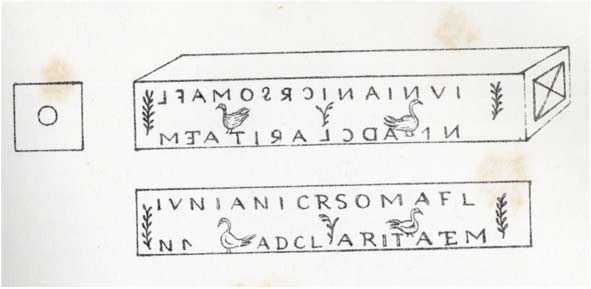
This small artefact certainly has been inscribed for advertising purposes. If you look at the top line-drawing you will see that the lettering is reversed. This is because it was designed to be pressed onto a block of eye ointment!
The second picture shows what would be printed on the ointment: the name of the eye-doctor: Junianus.
We can also see that the purpose of the ointment was to improve vision: AD CLARITATEM = for clarity.
It is unfortunate that this artefact is no longer in the possession of the museum. It was lost during the last century, but not before the line-drawing had been made.
P8.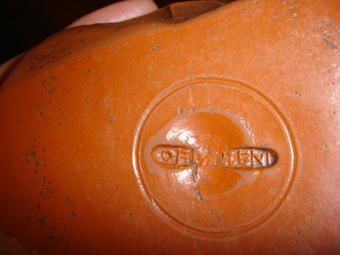
Modern pottery and china has the maker's mark on the base of the pot, on the outside. This is a fragment of Samian pottery, found all over the Roman Empire and imported from Gaul. The maker's stamp is on the inside of the pot.
The first three letters OFF , are short for 'officina' = from the workshop ...
Next comes the name of the potter, in the Genitive case to convey 'of' = PASSIENI.
"From the workshop of Passienus".
Comparison with other Samian ware shows that this was made by a potter in La Graufesenque, near Millau, during the reign of Nero or Vespasian.
Other makers' marks can be found on artefacts in the museum, particularly on some stone blocks just by Sulinus' workstation opposite the entrace to the Great Bath. It is thought that these would be used by the foreman to count how many each workman had made so that his pay could be calculated accordingly.
And ...
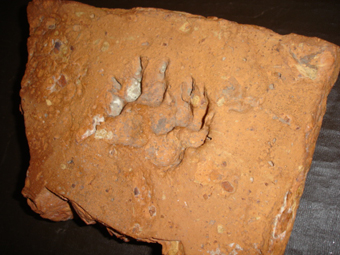
... a dog who trod on a tile as it was setting has left his signature for posterity!
P9.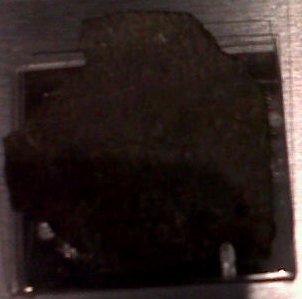
This is a Diploma or discharge certificate for a Roman soldier.
It is difficult to get a clear photograph of this so it is better to look at the line-drawing. This one is certifying the grant of citizenship (CIVITAS) to a soldier who has completed his years of service in an auxiliary unit. It is dated 15th September (17 days before the Kalends or first day of October - counting inclusively) but the year is not given.
Tribesmen from different parts of the Empire were very keen to sign up to serve in the cavalry because the status of Roman citizenship was included in the retirement package. They would obviously not be sent to serve in any area near their homeland and that is one reason why we see tombstones of soldiers from all around the Empire in Britain.
P10.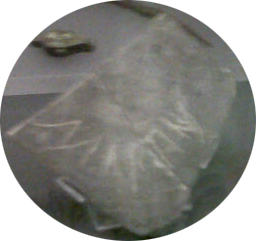
Graffito with the name of Martinus in the Genitive case 'MARTINI'. This means "of Martinus" or "Martinus's", so perhaps he had scratched his name onto his own personal bowl or dish!
Another interpretation is that it might be a voting token, with the name scratched on after the pot had been broken, but this is less likely since Martinus' name would be written 'Martinus' rather than 'Martini' = Martinus's.
Items found in the sacred spring.
P11.

Several 'paterae' or small dishes have been found in the sacred spring. Some have the name of the goddess scratched or inscribed on the handles, as do several objects dedicated to her.
One of these paterae has a pattern on the handle which looks like a fortified wall. This is one of four paterae in the Roman world which show Hadrian's Wall: perhaps this pan was part of a soldier's own kit which he had bought as a souvenir there and used for his personal cooking, later deciding to dedicate it to the goddess.
P12.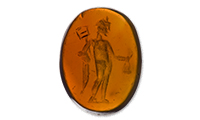
Many gemstones have been found in the overflow to the spring and it is unclear whether they were thrown in as a group or if they were lost from individuals' rings, perhaps accidentally. The Roman Baths website gives detailed information about these.
There must be stories behind why people chose particular designs for their seals: this one, which shows the god Mercury, could have belonged to a merchant since Mercury was the god of Trade.
P13.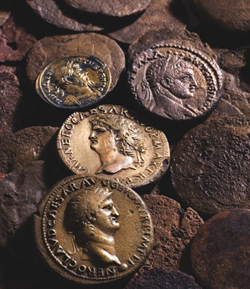
Coins - why should they be included on this page? Twelve and a half thousand coins have been found in the sacred spring, where they had presumably been thrown as offerings. Many would represent a month's salary for a Roman soldier, so they must have believed that the goddess had powers worthy of such a precious gift.
Coins were used by successive Roman Emperors as a powerful tool for propaganda. In a society without easy mass communication, imagine the effect of a powerful profile like those shown here, the Emperor's names and titles around the edge and then on the reverse, a simple message: CONCORDIA (Harmony), FORTUNA (Good Fortune), PIETAS (dutifulness), which the Emperor hoped would be associated with his rule. There are also personifications of cities such as Roma and provinces such as Britannia. Britannia first appeared on the reverse of coins struck by Hadrian to mark his visit to Britain in 122 AD.
In the later Empire, propaganda was more blatant. Many issues, such as the coins with the legend Gloria Exercitus ('to the glory of the army') were designed to flatter soldiers and keep them loyal. On the 1100th anniversary of the foundation of Rome massive issues of coins bore the legend FEL(ix) TEMP(orum) R(eparatio), literally 'the renewal of good times' or 'happy days are here again' - a rather optimistic view of the mid-4th century AD!